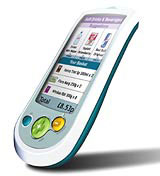Empower pack
Natalie Adams looks at the work featured in this year’s Design Business Association Design Challenge

Feeling comfortable, being able to find our way around, going shopping when and how we like, even drinking out of a paper cup are things most of us take for granted, but they are huge issues for the less able bodied.
Coley Porter Bell, Kinneir Dufort and Appliance Studio, Pearlfisher, PSD Fitch and SiebertHead took up the challenge at the Royal College of Art last week to improve existing systems and products to benefit disabled and able-bodied people at the Design Business Association Design Challenge, awarding innovation through inclusive design, in association with the Helen Hamlyn Research Centre.
It’s the third challenge in which the proposals submitted are put through tests by user groups with a range of disabilities, to enable the teams to develop their ideas based on personal experiences. Developing the projects for inclusive use was paramount in their validity.
HHRC director Roger Coleman, DBA director Julian Grice, Adrian Berry at Factory Design, Professor of textiles at the RCA Clare Johnston and consultant designer of intelligence fibres at Philips Design Nancy Tilbury all voted CPB’s C System the winner. They felt the proposal successfully customised devices to individual needs, and was educational as well as being user friendly. The project comprises a ‘smart’ clothing tag system to enable the visually impaired to make independent colour choices.
The consultancy plans to develop the project internally and is speaking to retailers about the possibility of producing it for public use.
Coley Porter Bell
C System consists of a range of shapes and a colour palette, with a clothing tag system. Each shape denotes a primary colour with sections of each shape representing colour saturation. A pictorial form of braille, the user is able to make choices about colour and patterns of clothes without having to rely on the advice of others.
Kinneir Dufort and Appliance Studio
Kinneir Dufort worked in partnership with technical innovation company Appliance Studio to develop Shop Sense, a user-friendly shopping environment enhanced by a hand-held product to guide users around the store. Simon Lewis, technical director at Appliance Studio, says that working with Kinneir Dufort was a ‘successful experience, complementing our technical experience with its solid product background.
We hope to share the experience within the company and look at all future projects in a different light. ‘Undertaking the Design Challenge has undoubtedly been a positive experience; it introduces an entirely new angle to user-focused design that previously has been neglected.’
SiebertHead
Handle with care is the development of the humble paper cup, allowing the user to drink with dignity while on the move or in a public space. It’s easy to grip and has a lid with a handle for an optional way to carry your drink. It was designed to be ‘a million miles away from a baby’s drinking cup’. Alistair Russell, senior structural designer at SiebertHead, says that the real challenge was ‘building in the needs and requirements of more abled consumers, as well as considering the issues for arthritic or visually impaired people. Designers are used to working and thinking in a visual way all the time. This has taught us to consider other senses too’.
PSD Fitch
I – Connect is a concept addressing issues that everyone faces while making travel connections. Looking at London’s Waterloo station and the common need to make connections during a journey, the team wanted to create a system taking all individual needs into account. Based on feedback from the user group, the team developed a system of wayfinding using a wrist display to access information, and an earpiece to receive audio communication. A navigation trail leads travellers on to the concourse and to other Tube lines or platforms, an information wall gives details on the surrounding area and a ‘white space’ can be created in the hustle and bustle to cancel out surrounding noise.
PSD Fitch is developing a new wayfinding project for Liverpool town centre and, as a result of taking part in the Design Challenge, has made room for an inclusive agenda. ‘We’re starting to see connections with existing and potential clients’, says head of environments Stephen Green.
Having already had user group experience on projects for public use, Green says it underlines the value of inclusivity. ‘It’s easy for designers to consider the disabled (when working on projects), but as the HHRC underlines, if you can design well for the disabled, you can design well for everyone,’ he says.
Pearlfisher
Smart wearables is a fashion collection for young people with disabilities. In her research with the user group, creative partner Karen Welman established the need for cool, stylish clothing that was functional for disabled people, but also kept them up to date with the latest trends. The line features smart materials, consisting of self-regulating temperature textiles and crease-resistant technology. Zips and magnetic buttons allow easy access for dressing. This is a new area for the company, which plans to develop more fashion projects in future.
-
Post a comment




